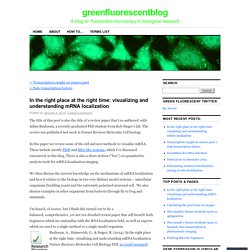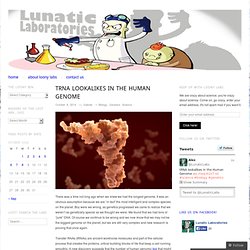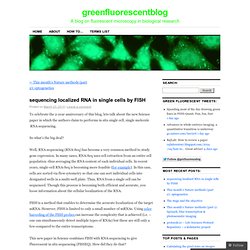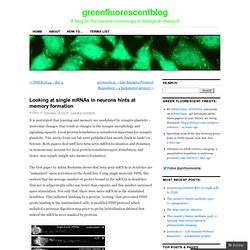

The alien within: Fetal cells influence maternal health during pregnancy (and long after) Parents go to great lengths to ensure the health and well-being of their developing offspring.

The favor, however, may not always be returned. Dramatic research has shown that during pregnancy, cells of the fetus often migrate through the placenta, taking up residence in many areas of the mother’s body, where their influence may benefit or undermine maternal health. The presence of fetal cells in maternal tissue is known as fetal microchimerism. The term alludes to the chimeras of ancient Greek myth–composite creatures built from different animal parts, like the goat-lion-serpent depicted in an Etruscan bronze sculpture. According to Amy Boddy, a researcher at Arizona State University’s Department of Psychology and lead author of a new study, chimeras exist.
“Fetal cells can act as stem cells and develop into epithelial cells, specialized heart cells, liver cells and so forth. Fetal cells may do more than simply migrate to maternal tissues. But, as co-author Wilson Sayres, cautions, Early pregnancy maternal hypothyroxinemia and offspring ADHD symptoms. Does maternal asthma 'prime' for offspring neurodevelopmental disorder? Squid prolifically edit RNA to enrich their DNA. In the right place at the right time: visualizing and understanding mRNA localization.
The title of this post is also the title of a review paper that I co-authored with Adina Buxbaum, a recently graduated PhD student from Rob Singer’s lab.

The review was published last week in Nature Reviews Molecular Cell biology. In this paper we review some of the old and new methods to visualize mRNA. These include mostly FISH and MS2-like systems, which I’ve discussed extensively in this blog. There is also a short section (“box”) on quantitative analysis tools for mRNA localization imaging. We then discuss the current knowledge on the mechanisms of mRNA localization and how it relates to the biology in two very distinct model systems – unicellular organisms (budding yeast) and the extremely polarized neuronal cell. Buxbaum, A., Haimovich, G., & Singer, R. (2014). MicroRNAs and Chronic Fatigue Syndrome. tRNA lookalikes in the Human Genome. There was a time not long ago when we knew we had the longest genome.

It was an obvious assumption because we are “in fact” the most intelligent and complex species on the planet. Boy were we wrong, as genetics progressed we came to realize that we weren’t as genetically special as we thought we were. Maternal complement C1q and offspring psychosis. Eternal Sunshine of the Spotless Mind? A frame from Eternal Sunshine of the Spotless Mind.

What if it was more than just a movie… Much like this posts namesake, the movie Eternal Sunshine of the Spotless Mind asked what if you could erase memories? Want to forget your ex, no problem. Better yet, what PTSD? I’m sure that all of us can think of at least one or two things — be it embarrassing, or scary — that we would like to forget.
Or conversely, maybe there is something forgotten, something you would give anything to remember — like a loved one or a relative — locked away deep in your brain. Researchers at the University of California, San Diego School of Medicine have done just that. They found that they could selectively remove a memory and more important, predictably reactivate it. The tests were ingeniously done with rats, that were genetically modified to make their nerves sensitive to light [see: optogenetics]. Sequencing localized RNA in single cells by FISH. To celebrate the 2-year anniversary of this blog, lets talk about the new Science paper in which the authors claim to performs in situ single cell, single molecule RNA sequencing.

So what’s the big deal? Well, RNA sequencing (RNA-Seq) has become a very common method to study gene expression. In many cases, RNA-Seq uses cell extraction from an entire cell population -thus averaging the RNA content of each individual cells. In recent years, single-cell RNA-Seq is becoming more feasible (for example). In this case, cells are sorted via flow cytometry so that one can sort individual cells into designated wells in a multi-well plate.
FISH is a method that enables to determine the accurate localization of the target mRNA. The Next Generation: The alternate routes of allergic responses. Claimtoken-5326210a079e4 As spring approaches for the northern hemisphere (or as a cat approaches from across the room), allergy sufferers might wonder about how their symptoms originate.

In some ways, they're in luck. The molecules involved in allergic reactions have been studied for decades, and to some extent, we've developed a cohesive picture of how these molecules work together. However, the immune system is always full of surprises. Here are some newly-discovered and seemingly fundamental roles for proteins that we knew existed, but that rarely made appearances in review papers. Background: The signals before the sneezes. Looking at single mRNAs in neurons hints at memory formation. It is postulated that learning and memory are modulated by synaptic plasticity – molecular changes that result in changes in the synapse morphology and signaling capacity.

Local protein translation is considered important for synaptic plasticity. Two works from our lab were published last month (back to back!) In Science. MAR autism and maternal autoimmune conditions: speculations. 5-Methylcytosine in RNA is More Common and Widespread than Previously Known! The existence of 5-methylcytosine (5-mC) in nucleic acid has been known for more than 50 years, and the majority of research in the past has focused on 5-mC in DNA.

However, 5-mC is also present in RNA and interest in this RNA modification has been increasing in recent years. To date, several roles of the 5-mC modification in RNA have been explored. In tRNA, 5-mC sites are typically located around the variable region and anticodon loop and research has shown that tRNA methylation stabilizes tRNA secondary structure, affects aminoacylation and codon recognition, and confers metabolic stability. More Methylation in RNA!?! RNA Continues to Surprise… While DNA methylation is an extensively-studied epigenetic modification, relatively little is known about the methylation of cytosine bases in RNA.

Although the functional consequences of RNA modifications are not clear, RNA molecules are known to be extensively modified. In fact, there are over 100 reported modifications to RNA, which is even more than are currently known for DNA. Recently, Hussain et al. developed a new technique for site-specific detection of 5-methylcytosine in RNA, which they coined Methylation individual-nucleotide-resolution CrossLinking and ImmunoPrecipitation, or miCLIP. The authors employed their miCLIP method to explore the targets of NSun2 and found that tRNAs, mRNAs, and ncRNAs were all targets of this protein. They confirmed their findings using other available techniques to detect cytosine methylation in RNA, such as bisulfite conversion and 5-azacytidine-mediated immunoprecipitation, validating the miCLIP method.
Maternal immune activation and monkeys continued. I jest of course.

But the theme of monkey research runs strong in today's post as I introduce the paper by Melissa Bauman and colleagues* adding yet further evidence to the possible connection between maternal immune activation (let's call it MIA for short) and offspring behavioural development and characteristics. For those with a close eye on autism and schizophrenia research, you'll probably already have heard of the work of Paul Patterson and colleagues (see here) and that coming out of the MIND Institute (see here) on how mothers' immune function during pregnancy might influence the risk of offspring presenting with said conditions. Indeed, with no clinical advice given or intended, the extended work looking into things like the use of suramin (see here) on offspring of mouse models with MIA in mind is also worthy of attention (note: the stress is on mouse models not human models). This is interesting data of that there is no doubt.
. * Bauman MD. et al. ** Bauman MD. et al. Induced labour, maternal thyroid hormone and autism. Erasing Breast Cancer: miRNAs and Epigenetic Factors Play Key Roles in Aggressive Breast Cancer Mechanisms. Cancer research is perhaps the poster child for the importance of integrating epigenetic analyses into a disease model. As research in the epigenetics of cancer continues to grow, relationships between myriad epigenetic regulators can become quite clear. In a recent study by Pier Paolo Pandolfi and colleagues, epigenetic players including microRNAs (miRNAs), chromatin-modifying enzymes, and methylated DNA were connected in new ways that yield important insights into molecular mechanisms behind a disease, as well as new potential therapeutic avenues. miR-22 is a miRNA that has long been implicated in several tumorigenic mechanisms, including regulation of PTEN and estrogen receptor α (ERα).
Yet Another Reason to Thank Dad This Father’s Day! Evidence for Paternally-Inherited Epigenetic Modifications. Maternal health during gestation and prenatal conditions are well documented as having profound effects on health and development of a baby after birth. The mechanisms behind many of these effects are attributed to epigenetic changes that take place in utero. More recently, pre-fertilization maternal health has been also been implicated in affecting development of babies after birth. Despite the growing evidence for pre-fertilization maternal effects, little research has focused on how paternal health and lifestyle might affect offspring. A recent paper provides the first hints as to what kind of role Dad’s health, at the time of conception, might play in the development of his children.
Old Dog, New Tricks? Cytosine Methylation in Long Non-Coding RNAs. Cytosine methylation (5-mC) in DNA is very common, and is generally associated with repression of gene expression. DNA methylation was the first discovered type of epigenetic modification and remains one of the most actively investigated epigenetic processes, especially with respect to its use as a valuable biomarker for cancer and other human diseases. The presence of RNA methylation has been known for years, however, the functional relevance and importance of this modification remains largely unknown. According to Dr. Alexandra Lusser, an internationally recognized expert in epigenetics research, “Internal RNA modifications in poly(A)-RNAs may play diverse roles, including [regulation of] splicing, RNA stability, transport or interaction with protein binding partners.” A recent paper by Dr.
If you chew that mRNA, you must make a new one! Gene expression is very complex. My paper, which was published in Cell today, just shows that it is more complicated than previously realized. Traditionally, eukaryotic gene expression is divided into five steps: Transcription (mRNA synthesis): this step is subdivided into initiation (i.e. recruitment of specific & general transcription factors, which in turn recruit/activate RNA polymerase II (pol II) up to the synthesis of the first few nucleotides; then comes the elongation step and finally the termination . mRNA maturation: includes capping , splicing and polyadenylation (which occur co- or post- transcriptionally). mRNA export: export of the mRNA from the nucleus into the cytoplasm Translation mRNA decay (degradation): this step is subdivided into deadenylation (removal of the poly-A tail), followed by decapping (removal of the 5’ cap) and ending in exonucleolytic digestion to single nucleotides.
Shuttling proteins FISHing for transcription. RNA was able to do some complex tasks in the start of Life on Ancient Earth. RNA was capable of catalyzing electron transfer on early earth with iron’s help, study shows. I 1 Vote A new study shows how complex biochemical transformations may have been possible under conditions that existed when life began on the early Earth. May 19, 2013 | Abby Robinson | Georgia Institute of Technology The study shows that RNA is capable of catalyzing electron transfer under conditions similar to those of the early Earth.
Because electron transfer, the moving of an electron from one chemical species to another, is involved in many biological processes – including photosynthesis, respiration and the reduction of RNA to DNA – the study’s findings suggest that complex biochemical transformations may have been possible when life began. Scientists Create Novel Approach to Find RNAs Involved in Long-term Memory Storage. FISH-quant, a new RNA-FISH analysis tool. RNA FISH is a powerfull tool to measure not only the amount of mature mRNAs in the cytoplasm (or other compartments) but also to asses the amount of nascent transcripts that are still at the transcription site. These nascent transcripts are RNAs that are still in the elongation or termination step of transcription (i.e. have not moved out ot the transcription site, where the gene is located). Soaking up the Competition – Circular RNAs as Molecular Sponges for miRNAs. Numerous families of non-coding RNAs have been identified in mammalian cells, including lncRNA, miRNA, siRNA, and piRNA.
Go home, RNA, you're drunk. MIND the maternal autoantibodies in autism. It's been a few weeks since I posted on research coming out of the MIND Institute. Regular readers will probably already know that I'm quite interesting in the various investigations on autism from UC Davis, and in particular how they are very usefully starting to think about subgroups and endophenotypes when it comes to autism as per the quite significant heterogeneity (and comorbidity) present across the spectrum. The Importance of Epigenetic Modification of RNA in miRNA Maturation and Breast Cancer. Two colors, single mRNA, and a multitude of transcription rates.
The Transposon/piRNA/Chromatin Nexus. Uploading piRNAs to the Cloud. A chimeric fusion of RNA and DNA viruses. Nucleolar VHL regulates rRNA synthesis under hypoxic conditions. FLCN regulates ribosomal RNA synthesis. Παρατήρηση σύνθεσης RNA σε πραγματικό χρόνο « Tracing Knowledge … Στα ίχνη της Γνώσης. Eternal sunshine of the drugless mind… « science left untitled.
Opening up the RNA-chromatin network. MicroRNAs punch Plasmodium parasites in the face. Human blood metabolite timetable indicates internal body time « Tracing Knowledge … Στα ίχνη της Γνώσης. Whole-transcriptome RNA-Seq analysis from archival FFPE tumor samples (Part 2) Tiny RNA fragments control bacterial infections. Interacting small RNA pathways in worms 5: Global Genome Surveillance. Detecting Gene Doping in Sports: MicroRNA biomarker sought. Ribosomal profiling to determine mechanisms of miRNA-mediated regulation in C. elegans. Interacting small RNA pathways in worms 4: 21U-RNAs. Epistasis between mutations is host-dependent for an RNA virus « Tracing Knowledge … Στα ίχνη της Γνώσης. Interacting small RNA pathways in worms 3: CSR-1 associated 22G-RNAs. Interacting small RNA pathways in worms 2: 22G-RNAs. A dual purpose RNA and Hox regulation. Patterns of RNA methylation.
MiRNA profiling as a biomarker for human cancer. Fixing mitochindrial mutations with targeted mitochondrial RNA import. Evaluation of rRNA removal methods for complex microbial samples. Downstream CpG islands control transcription initiation and elongation of ncRNA. Cryptic genetic variation promotes rapid evolutionary adaptation in an RNA enzyme (Hayden et al, Nature, 2011) Double-strand break interacting RNAs (diRNAs) It’s not over until the RNA sings… Large intergenic noncoding RNAs affect gene expression. Small silencing RNAs. I: Piwi-interacting RNAs. Transcriptome-wide discovery of circular RNAs in Archaea. Hibernation, Life in the Slow Lane. RNAi and Chromatin Modification. LincRNAs in development and evolution. Eternal Sunshine of the Spotless Slug. Transposome-based RNA-Seq library construction from low input amounts of RNA. The fundamental role of RNA editing.
Video Tip of the Week: MapMi, automated mapping of microRNA loci. RNA. Medicinal leeches, MasterPure RNA Kits, and metatranscriptomics. 2011 UGA Conference on Drug Discovery: anti-HIV RNAs, enhanced DNA vaccines, and adenosine ligands « Antiviral Immunity. The Influence of Late Quaternary Climate-Change Velocity on Species Endemism : Greg Laden's Blog. Barnacles (Crustacea: Cirripedia) « Teaching Biology. Rule of 6ix: On the experimental generation of endogenous (non-retroviral) RNA viruses. Rule of 6ix: miRNAs, viruses and high blood pressure. Breakdown: Science's Smaller Questions: RNA pushing the limits: Challenging Central Dogma. Origins of Life: General RNA Polymerases. Antibodies.